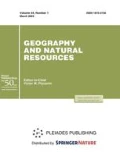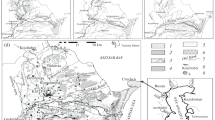Abstract
A brief geographical description is provided for Lake Khanka and its drainage basin where the Russian part accounts for more than 90% of the area. Sixteen rivers on the Russian territory and eight rivers on the Chinese territory flow into the lake. Only one river, Sungacha, flows out of the lake; it is a border river and connects Lake Khanka with the Ussuri river. A historical analysis of the water level dynamics in Lake Khanka for the last 10 thousand years showed that rises of the lake water level, shore erosion, an increase in flood frequency and duration, and an increase of the degree of waterlogging of the valleys corresponded to warm climatic phases. The cold phases showed a decrease in hydraulicity of the rivers and in the lake level, and an enhancement in aeolian processes in the coastal zone of the lake and its river valleys. Seismic processes and changes in groundwater flow can also be responsible for changes in the lake water level. Morphostructural analysis indicates a potentially high seismic activity of this territory and risks of magnitude 8 earthquakes. In the 20th century, the natural processes of water level fluctuations in the lake began to be influenced by anthropogenic factors, such as the water withdrawal for irrigation of paddy fields and streamflow control. The territory of China within the Lake Malaya Khanka drainage basin is the home for extensive paddy systems which are supplied with water from the Muling river basin. The water is then directed to Lake Malaya Khanka, and through the drain facilities it enters Lake Khanka. In fact, an inter-basin transboundary water transfer is carried out, which can affect significantly the water level in the lake. Characteristics of the existing nature management practices in the Russian portion of the lake drainage basin, and also lake pollution assessments are given. The main geo-ecological problems in the Lake Khanka transboundary drainage basin associated with water level fluctuations, geodynamic processes and environmental pollution are identified. Geo-ecological problems are considered to mean changes in natural processes accompanied by the transformation of separate natural components and landscapes in general, and causing, as a rule, negative consequences for humans and for various forms of nature management. The primary and related components of the geo-ecological problems highlighted. The main directions of comprehensive research within the framework of cooperation between the People’s Republic of China and the Russian Federation in order to work out the plan for governance of sustainable nature management in the transboundary drainage basin of Lake Khanka are suggested.
Similar content being viewed by others
References
Geosystems of the Far East in the Late 20thand Early 21stCenturies, P.Ya. Baklanov, Ed., 3 vols., Vladivostok: Dal’nauka, 2008–2012 [in Russian]. 364 c.
Zhuravlev, Yu.N., Klyshevskaya, S.V., Novikova, P.A., Gyzev, M.A., Nikitina, E.Yu., and Timofeeva, Ya.O., Study of the Lake Khanka Fluctuations, Vestn. DVO RAN, 2018, no. 4(200), pp. 88–94 [in Russian].
Program of Sustainable Land Use and Land Management Within the Ussuri River Basin and on Central Sikhote-Alin (Russian Far East and North-East China). Joint Project With the Participation of Scientific Organizations of the USA, PRC and RF, D.D. Davis and D.M. Lampton, Eds., New York, 1997 [in Russian, English and Chinese].
Nakamura, T., Xiangcan, J., Kachur, A, et al., Diagnostic Analysis of the Lake Xingkai (Khanka Basin) (People’s Republic of China and Russian Federation). United Nations Environment Programme, Chinese Research Academy of Environmental Sciences, Pacific Geographical Institute FEB RAS, UNEP: Nairobi, 2001.
Proc. I Far Eastern Conf. “Transboundary Lake Khanka: Causes of Rising Water Levels and Environmental Threats (April 27–29, 2016, Vladivostok), Yu.N. Zhuravlev and S.V. Klyshevskaya, Eds., Vladivostok: Dal’nauka, 2016 [in Russian].
Korotkii, A.M., Grebennikova, T.A., Karaulova, L.P., and Belyanina, N.I., Lacustrine Transgressions in the Late Cenozoic Ussuri-Khanka Depression (Primor’e), Russ. J. Pac. Geol., 2007, vol. 1, issue 4, pp. 352–365.
Mikishin, Yu.A., Petrenko, T.I., Popov, A.B., and Orlova, L.A., Paleography of Lake Khanka in the Late Holocene, Nauchnoe Obozrenie, 2007, no. 2, pp. 7–13 [in Russian].
Bazarova, V.B., Mokhova, L.M., Orlova, L.A., and Belyanin, P. S., Variation of the lake Khanka Level in the Late Holocene, Primor’e, Russ. J. Pac. Geol., 2008, vol. 2, issue 3, pp. 272–276.
Bazarova, V.B., Lyashchevskaya, M.S., Makarova, T.R., and Orlova, L.A., Environments of the Middle-Late Holocene Sedimentation in the River Flood-Plains of the Prikhanka Plain (Southern Far East), Russ. J. Pac. Geol., 2018, vol. 59, no. 11, pp. 94–105 [in Russian].
Bazarova, V.B., Lyashchevskaya, M.S., Makarova, T.R., and Orlova, L.A., Holocene Overbank Deposition in the Drainage Basin of Lake Khanka, Russ. Geol. Geophys., 2018, vol. 59, issue 11, pp. 1410–1418.
Tashchi, S.M. and Ermoshin, V.V., Vulnerability of Geological-Geomorphological Structures and Sustainable Development of a Territory, in Sustainable Development of the far Eastern Regions: Ecological-Geographical Aspects, P.Ya. Baklanov, Ed., Vladivostok: Dal’nauka, 1999, pp. 163–175 [in Russian].
Kulakov, A.P. and Myasnikov, E.A., The Lake Khanka Drainage Basin: New Concepts of the Morphostructure and Seismic Hazards, Vestn. DVO RAN, 2008, no. 4, pp. 51–57 [in Russian].
Vas’kovskii, M.G., Level Regime of Lake Khanka, in Technique for Calculating and Forecasting the Streamflows of the Far East, V.M. Lylo, Ed., Leningrad: Gidrometeoizdat, 1968, pp. 155–182 [in Russian].
Bogoslovskii, B.B., Limnology, Moscow: Izd. Mosk. Univ., 1960 [in Russian].
Bolgov, M.V., Extreme Levels of Khanka Lake: Natural Variation or Anthropogenic Interference? Vestn. Otd. Nauk o Zemle, 2016, vol. 8, NZ1001. URL: https://onznews.wdcb.ru/doi/2016NZ000127-res.html (Accessed Oct. 2, 2018) [in Russian].
Baklanov, P.Ya., Kasyanov, V.L. and Kachur, A.N., The Main Ecological Problems of the Russian Far East and Directions to Solve Them, Vestn. DVO RAN, 2003, no 5, pp. 109–119 [in Russian].
Long-Term Program of Nature Conservation and Natural Resource Management in Primorskii Krai Into 2005 (Ecological Program), G.B. Elyakov, Ed., Vladivostok: Dal’nauka, in Two Parts, 1992–1993 [in Russian].
Semykina, G.I., An Overview of the Condition and Pollution of Lake Khanka Based on the State Environmental Pollution Monitoring Data, Proc. Int. Sci. Conf. “Problems of Preservation of Wetlands of International Importance: Lake Khanka” (June 10–11, 2006, Spassk-Dalnyi), Vladivostok: OO RITz Idea, 2006, pp. 190–200 [in Russian].
Boyarova, M.D., Current Content Levels of Chlororganic Pesticides in Aquatic Organisms of the Peter the Great Gulf (Sea of Japan) and Lake Khanka, Extended Abstract of Cand. Sci. (Biol.) Dissertation, Vladivostok, 2008, 28 p. [in Russian].
Kataikina, O.I., Simokon’, M.V., Matveev, V.I., and Kovekovdova, L.T., Assessing the Water Quality in Lake Khanka for Metals and Arsenic Contents, Proc. Second All-Russian Conf. With International Participation “Far Eastern Seas and Their Basins: Biodiversity, Resources, Environmental Problems (October 3–4, 2017, Vladivostok), Vladivostok: Izd. Far Eastern Univ., 2017, pp. 74–77 [in Russian].
Gershtein, V.V., Problems and Ways of Further Russian-Chinese Cooperation on the Preservation of Fish Bioresources of Lake Khanka, Proc. X Far-Eastern Von. On Nature Conservation Problems (September 25–27, 2013, Blagoveshshensk), Blagoveshchensk: Izd. Blagoveshch. Ped. Univ., 2013, pp. 91–94 [in Russian].
Sun, J., Chen, Y., Zhang, Z., Wang, P., Song, X., Wei, X., and Feng, B., The Spatio-Temporal Variations of surface water quality in China during the “Eleventh Five-Year Plan”, Environ. Monit. Assess., 2015, vol. 187:64, issue 3. URL: https://doi.org/10.1007/s10661-015-4278-z (Accessed Oct. 2, 2018).
Zhang, H., Lu, X., Zhang, Y., Ma, X., Wang, S., Ni, Y., and Chen, J., Bioaccumulation of Organochlorine Pesticides and Polychlorinated Biphenyls by Loaches Living in Rice Paddy Fields of Northeast China, Environ. Pollut., 2016, vol. 216, pp. 893–901.
Author information
Authors and Affiliations
Corresponding authors
Additional information
This work was done within the “Far East” FEB RAS Program (AAAA-A18-118111290006-4)
Russian Text © The Author(s), 2019, published in Geografiya i Prirodnye Resursy, 2019, Vol. 40, No. 4, pp. 33–43.
Rights and permissions
About this article
Cite this article
Baklanov, P.Y., Kachur, A.N., Ermoshin, V.V. et al. Current Geo-Ecological Problems Within the Lake Khanka Drainage Basin. Geogr. Nat. Resour. 40, 325–334 (2019). https://doi.org/10.1134/S1875372819040048
Received:
Published:
Issue Date:
DOI: https://doi.org/10.1134/S1875372819040048




